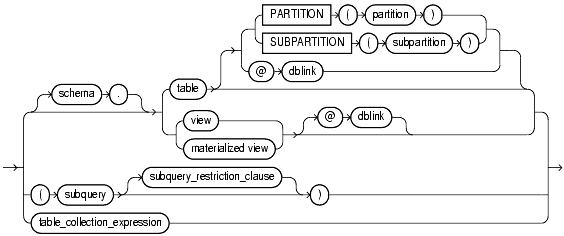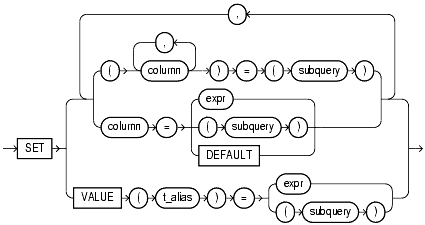| Oracle9i SQL Reference Release 2 (9.2) Part Number A96540-02 |
|
|
View PDF |
| Oracle9i SQL Reference Release 2 (9.2) Part Number A96540-02 |
|
|
View PDF |
Use the UPDATE statement to change existing values in a table or in a view's base table.
For you to update values in a table, the table must be in your own schema or you must have UPDATE privilege on the table.
For you to update values in the base table of a view:
UPDATE privilege on the view, andUPDATE privilege on the base table.The UPDATE ANY TABLE system privilege also allows you to update values in any table or any view's base table.
You must also have the SELECT privilege on the object you want to update if:
SQL92_SECURITY initialization parameter is set to TRUE and the UPDATE operation references table columns (such as the columns in a where_clause).update::=

DML_table_expression_clause::=

subquery::=--part of SELECT syntax, subquery_restriction_clause::=, table_collection_expression::=)subquery_restriction_clause::=

table_collection_expression::=


where_clause::=


Specify a comment that passes instructions to the optimizer on choosing an execution plan for the statement.
You can place a parallel hint immediately after the UPDATE keyword to parallelize both the underlying scan and UPDATE operations.
See Also:
|
The ONLY clause applies only to views. Specify ONLY syntax if the view in the UPDATE clause is a view that belongs to a hierarchy and you do not want to update rows from any of its subviews.
Specify the schema containing the table or view. If you omit schema, then Oracle assumes the table or view is in your own schema.
Specify the name of the table, view, materialized view, or the columns returned by a subquery, to be updated. Issuing an UPDATE statement against a table fires any UPDATE triggers associated with the table.
If you specify view, then Oracle updates the view's base table. You cannot update a view except with INSTEAD OF triggers if the view's defining query contains one of the following constructs:
DISTINCT operatorGROUP BY, ORDER BY, CONNECT BY, or START WITH clauseSELECT listSELECT listIn addition, if the view was created with the WITH CHECK OPTION, then you can update the view only if the resulting data satisfies the view's defining query.
If table (or the base table of view) contains one or more domain index columns, then this statement executes the appropriate indextype update routine.
If you specify materialized view, then Oracle updates the data in the materialized view if it using the FOR UPDATE clause.
See Also:
|
Specify the name of the partition or subpartition within table targeted for updates. You need not specify the partition name when updating values in a partitioned table. However in some cases specifying the partition name can be more efficient than a complicated where_clause.
Specify a complete or partial name of a database link to a remote database where the table or view is located. You can use a database link to update a remote table or view only if you are using Oracle's distributed functionality.
If you omit dblink, then Oracle assumes the table or view is on the local database.
| See Also:
"Referring to Objects in Remote Databases" for information on referring to database links |
Use the subquery_restriction_clause to restrict the subquery in one of the following ways:
Specify WITH READ ONLY to indicate that the table or view cannot be updated.
Specify WITH CHECK OPTION to indicate that Oracle prohibits any changes to the table or view that would produce rows that are not included in the subquery.
Specify the name of the CHECK OPTION constraint. If you omit this identifier, Oracle automatically assigns the constraint a name of the form SYS_Cn, where n is an integer that makes the constraint name unique within the database.
The table_collection_expression lets you inform Oracle that the value of collection_expression should be treated as a table for purposes of query and DML operations. The collection_expression can be a subquery, a column, a function, or a collection constructor. Regardless of its form, it must return a collection value (that is, a value whose type is nested table or varray). This process of extracting the elements of a collection is called collection unnesting.
|
Note: In earlier releases of Oracle, when |
You can use a table_collection_expression to update rows in one table based on rows from another table. For example, you could roll up four quarterly sales tables into a yearly sales table.
Specify a correlation name (alias) for the table, view, or subquery to be referenced elsewhere in the statement.
|
Note: This alias is required if the |
table (or the base table of view) contains any domain indexes marked IN_PROGRESS or FAILED.UNUSABLE.order_by_clause in the subquery of the dml_table_expression_clause.UNUSABLE, then the UPDATE statement will fail unless the SKIP_UNUSABLE_INDEXES session parameter has been set to TRUE.
| See Also:
ALTER SESSION for information on the |
The update_set_clause lets you set column values.
Specify the name of a column of the table or view that is to be updated. If you omit a column of the table from the update_set_clause, then that column's value remains unchanged.
If column refers to a LOB object attribute, then you must first initialize it with a value of empty or null. You cannot update it with a literal. Also, if you are updating a LOB value using some method other than a direct UPDATE SQL statement, then you must first lock the row containing the LOB.
If column is part of the partitioning key of a partitioned table, then UPDATE will fail if you change a value in the column that would move the row to a different partition or subpartition, unless you enable row movement.
| See Also:
the |
In addition, if column is part of the partitioning key of a list-partitioned table, then UPDATE will fail if you specify a value for the column that does not already exist in the partition_value list of one of the partitions.
Specify a subquery that returns exactly one row for each row updated.
update_set_clause, then the subquery can return only one value.update_set_clause, then the subquery must return as many values as you have specified columns.You can use the flashback_clause of within the subquery to update table with past data.
| See Also:
the |
If the subquery returns no rows, then the column is assigned a null.
Specify an expression that resolves to the new value assigned to the corresponding column.
|
See Also: Chapter 4, "Expressions" for the syntax of |
Specify DEFAULT to set the column to the value previously specified as the default value for the column. If no default value for the corresponding column has been specified, then Oracle sets the column to null.
You cannot specify DEFAULT if you are updating a view.
The VALUE clause lets you specify the entire row of an object table.
You can specify this clause only for an object table.
|
Note: If you insert string literals into a |
The where_clause lets you restrict the rows updated to those for which the specified condition is true. If you omit this clause, then Oracle updates all rows in the table or view.
The where_clause determines the rows in which values are updated. If you do not specify the where_clause, then all rows are updated. For each row that satisfies the where_clause, the columns to the left of the equals (=) operator in the update_set_clause are set to the values of the corresponding expressions on the right. The expressions are evaluated as the row is updated.
| See Also:
Chapter 5, "Conditions" for the syntax of |
The returning clause retrieves the rows affected by a DML (INSERT, UPDATE, or DELETE) statement. You can specify this clause for tables and materialized views, and for views with a single base table.
When operating on a single row, a DML statement with a returning_clause can retrieve column expressions using the affected row, rowid, and REFs to the affected row and store them in host variables or PL/SQL variables.
When operating on multiple rows, a DML statement with the returning_clause stores values from expressions, rowids, and REFs involving the affected rows in bind arrays.
Each item in the expr list must be a valid expression syntax. All forms are valid except scalar subquery expressions.
The INTO clause indicates that the values of the changed rows are to be stored in the variable(s) specified in data_item list.
Each data_item is a host variable or PL/SQL variable that stores the retrieved expr value.
For each expression in the RETURNING list, you must specify a corresponding type-compatible PL/SQL variable or host variable in the INTO list.
You cannot:
returning_clause for a multitable insert.LONG types with this clause.INSTEAD OF trigger has been defined.
| See Also:
PL/SQL User's Guide and Reference for information on using the |
The following statement gives null commissions to all employees with the job SH_CLERK:
UPDATE employees SET commission_pct = NULL WHERE job_id = 'SH_CLERK';
The following statement promotes Douglas Grant to manager of Department 20 with a $1,000 raise:
UPDATE employees SET job_id = 'SA_MAN', salary = salary + 1000, department_id = 120 WHERE first_name||' '||last_name = 'Douglas Grant';
The following statement increases the salary of an employee in the employees table on the remote database:
UPDATE employees@remote SET salary = salary*1.1 WHERE last_name = 'Baer';
The next example shows the following syntactic constructs of the UPDATE statement:
update_set_clause together in a single statementwhere_clause to limit the updated rows
UPDATE employees a SET department_id = (SELECT department_id FROM departments WHERE location_id = '2100'), (salary, commission_pct) = (SELECT 1.1*AVG(salary), 1.5*AVG(commission_pct) FROM employees b WHERE a.department_id = b.department_id) WHERE department_id IN (SELECT department_id FROM departments WHERE location_id = 2900 OR location_id = 2700);
The preceding UPDATE statement performs the following operations:
department_id for these employees to the department_id corresponding to Bombay (location_id 2100)The following example updates values in a single partition of the sales table:
UPDATE sales PARTITION (sales_q1_1999) s SET s.promo_id = 494 WHERE amount_sold > 9000;
The following statement updates a row of object table table1 by selecting a row from another object table table2:
UPDATE table1 p SET VALUE(p) = (SELECT VALUE(q) FROM table2 q WHERE p.id = q.id) WHERE p.id = 10;
The example uses the VALUE object reference function in both the SET clause and the subquery..
The following example updates particular rows of the projs nested table corresponding to the department whose department equals 123:
UPDATE TABLE(SELECT projs FROM dept d WHERE d.dno = 123) p SET p.budgets = p.budgets + 1 WHERE p.pno IN (123, 456);
The following example returns values from the updated row and stores the result in PL/SQL variables bnd1, bnd2, bnd3:
UPDATE employees SET job_id ='SA_MAN', salary = salary + 1000, department_id = 140 WHERE last_name = 'Jones' RETURNING salary*0.25, last_name, department_id INTO :bnd1, :bnd2, :bnd3;